Using Satellite Thermal-Based Evapotranspiration Time Series for Defining Management Zones and Spatial Association to Local Attributes in a Vineyard
Abstract
1. Introduction
2. Materials and Methods
2.1. Study Area
2.2. Data Collection–ET Images, Environmental Attributes, and Yield
2.2.1. ET Images
2.2.2. Environmental Attributes
- Digital elevation model (DEM): Represents shifts in elevation (m) at a 30 m spatial resolution. The variability in elevation is known to affect plant conditions [59] and ET across space [60]. Within the study area, the elevation ranges between 37 and 47 m above sea level, with a median of 40.5 m above sea level.
- Slope: Derived from the DEM, with identical spatial resolution and coordinate system. It was computed as the highest difference between a certain pixel and its 8 neighboring cells [61] and was applied using the “raster” package in R [62]. The slope is known to have an impact on soil water content [63], thereby affecting the water availability to the plant [64] and its water consumption levels. The slope in the vineyard is considered moderate, ranging between 0 and 3.16°, with a median of 0.75°.
- Northness: Derived from the DEM with an inherent 30 m spatial resolution. Aspect was computed as the gradient vector at each pixel location according to the direction between neighboring pixels, such that the North is defined as 0° and south as 180°. The aspect was derived using the R package “raster” [62]. To avoid using a circular variable in a regression model, aspect was transformed to northness, which is the cosine of aspect [65,66]. Aspect is known to affect the levels of exposure to solar radiation by the plants, thereby influencing plant water conditions, with significant effects between North- and South-facing slopes [67]. The west side of the vineyard is mostly facing West, North, and North-West, while the East side of the vineyard is mostly facing East and South-East.
- Topographic wetness index (TWI): Represents soil moisture conditions and quantifies the distribution of accumulated area across downslope pixels. It was calculated by Equation (4) using the “dynatopmodel” package in R [68]:where A stands for the upstream contributing area (m2) for each pixel and β is the local slope in the steepest downhill direction (degrees). TWI is used to assess the soil moisture and its effects on plant conditions [69]. TWI levels ranged between 6 and 17 with a median of 9.TWI = ln(A/tanβ)
- Soil types: The soil type map represents different soil groups within the vineyard, represented as polygons, as classified in the Gridded Soil Survey Geographic (gSSURGO) Database. The soil types layer was spatially overlaid over the raster dataset to retrieve the indexes of the soil classes for each pixel, using R package “sp” [70]. Soil texture and structure are among the main attributes affecting soil moisture levels and soil water extraction patterns [71] due to variations in soil depth, permeability levels, micronutrients, and more [72,73]. In turn, these soil properties affect water availability to the plant and ET levels [74]. There are four soil type classes within the vineyard domain (SSHCP, 2018), including the following:Redding gravelly loam: Associated with the Laguna Formation, which is associated with high terrace landform, and composed of interbedded alluvial gravel, sand, and silt. This soil series developed on older, higher alluvial terrace landforms, is a well-drained, gravelly loam mineral soil that is moderately deep and formed in gravelly valley fill [75]. The water holding capacity in low and permeability is very slow, reaching 50-100 cm [72].Hadselvill-Pentz complex: Consists of very shallow loamy, moderately well-drained intermound soils. This soil series is associated with the Mehrten Formation, which consists of eroded, volcanic mudflow fans. It has organic matter content of 1%-2% and is very shallow [75], with moderately rapid permeability, reaching 10-50 cm. Water holding capacity is very low [72].Corning complex: Formed of gravelly loam from the Laguna Formation and gravels on high terraces. They have microrelief composed of a mound-intermound structure on smooth terrace side slopes. These are very deep soils, well-drained with a gravelly fine sandy loam surface layer [75]. Permeability in this soil series is very low. After rainfall events/irrigation, the soil is saturated for a short time [72].
- Lithology: The lithology map represents the spatial distribution of rock formation within the vineyard, represented as polygons, and the same technique was used to extract the classes representing each pixel as for the soil types layer. The lithology may have an effect on water availability to the plant [77] and its ability to consume water. This covariate included two classes – Sandstone on the northwest part of the plot and alluvium in the southeast part of the vineyard.
2.2.3. Yield
2.3. Time-Series Decomposition and Clustering of Each Component
2.4. Precipitation and Irrigation Data Analysis
2.5. Assessment of Spatial Similarity among TSC Maps
2.6. Influence of Field Attributes on ET Spatial Clustering Patterns
2.7. Effect of ET on Yield
3. Results
3.1. Time-Series Clustering
3.2. Irrigation and Precipitation
3.3. Assessment of Spatial Similarity among TSC Maps
3.4. Influence of Field Attributes on ET Spatial Clustering Patterns
3.5. Effect of ET on Yield
4. Discussion
5. Conclusions
Author Contributions
Funding
Acknowledgments
Conflicts of Interest
Appendix A. Time Series Decomposition
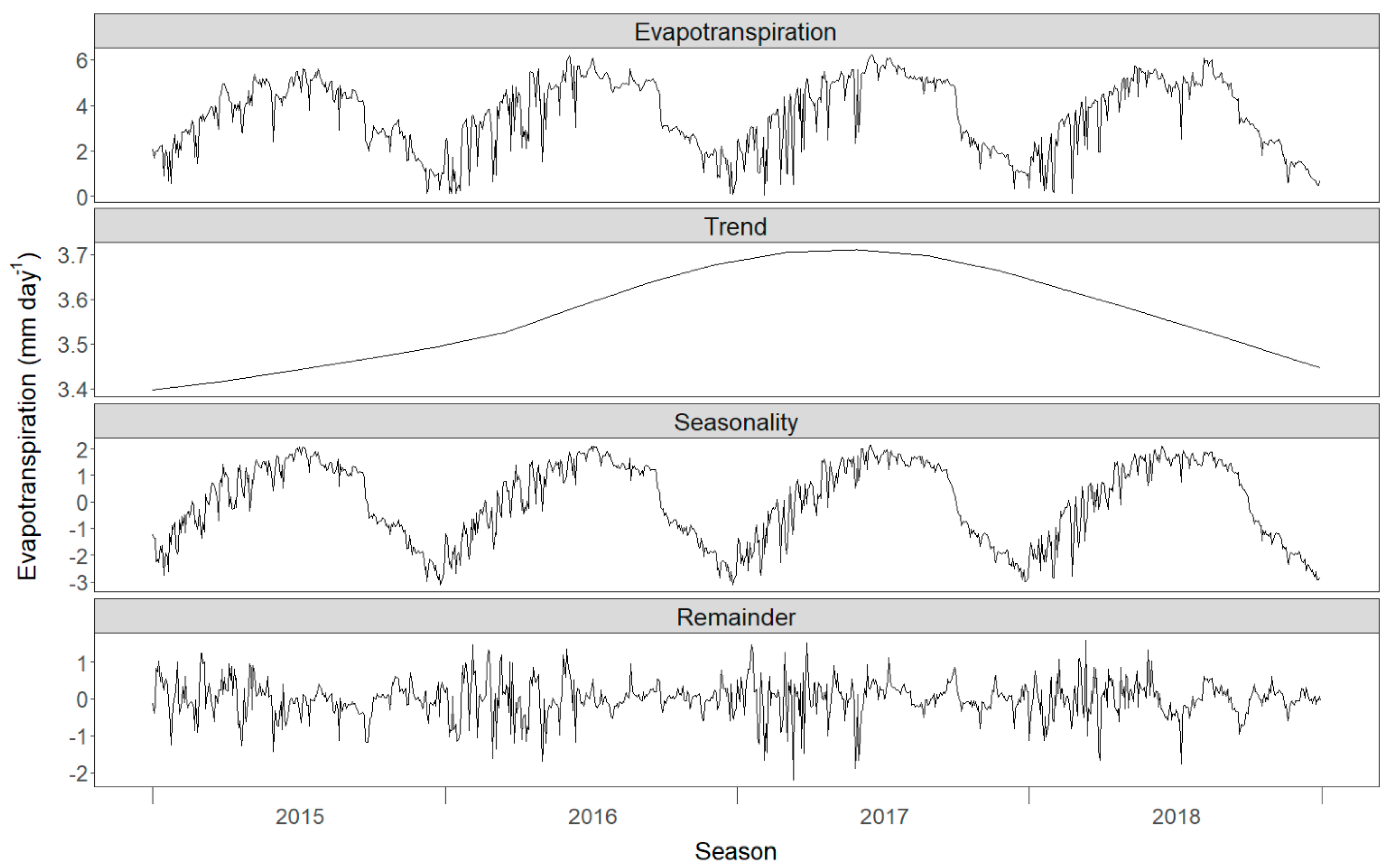
References
- Romero, M.; Luo, Y.; Su, B.; Fuentes, S. Vineyard water status estimation using multispectral imagery from an UAV platform and machine learning algorithms for irrigation scheduling management. Comput. Electron. Agric. 2018, 147, 109–117. [Google Scholar] [CrossRef]
- Chai, Q.; Gan, Y.; Zhao, C.; Xu, H.L.; Waskom, R.M.; Niu, Y.; Siddique, K.H.M. Regulated deficit irrigation for crop production under drought stress. A review. Agron. Sustain. Dev. 2016, 36, 1–21. [Google Scholar] [CrossRef]
- González Perea, R.; Daccache, A.; Rodríguez Díaz, J.A.; Camacho Poyato, E.; Knox, J.W. Modelling impacts of precision irrigation on crop yield and in-field water management. Precis. Agric. 2018, 19, 497–512. [Google Scholar] [CrossRef]
- Galindo, A.; Collado-González, J.; Griñán, I.; Corell, M.; Centeno, A.; Martín-Palomo, M.J.; Girón, I.F.; Rodríguez, P.; Cruz, Z.N.; Memmi, H.; et al. Deficit irrigation and emerging fruit crops as a strategy to save water in Mediterranean semiarid agrosystems. Agric. Water Manag. 2018, 202, 311–324. [Google Scholar] [CrossRef]
- Boutraa, T. Improvement of water use efficiency in irrigated agriculture: A Review. J. Agron. 2010, 9, 1–8. [Google Scholar] [CrossRef]
- Clemmens, A.J.; Dedrick, A.R. Irrigation Techniques and Evaluations; Springer: Berlin/Heidelberg, Germany, 1994; pp. 64–103. [Google Scholar]
- Rud, R.; Cohen, Y.; Alchanatis, V.; Levi, A.; Brikman, R.; Shenderey, C.; Heuer, B.; Markovitch, T.; Dar, Z.; Rosen, C.; et al. Crop water stress index derived from multi-year ground and aerial thermal images as an indicator of potato water status. Precis. Agric. 2014, 15, 273–289. [Google Scholar] [CrossRef]
- Van Leeuwen, C.; Seguin, G. The concept of terroir in viticulture. J. Wine Res. 2006, 17, 1–10. [Google Scholar] [CrossRef]
- Farid, H.U.; Bakhsh, A.; Ahmad, N.; Ahmad, A.; Mahmood-Khan, Z. Delineating site-specific management zones for precision agriculture. J. Agric. Sci. 2016, 154, 273–286. [Google Scholar] [CrossRef]
- Nawar, S.; Corstanje, R.; Halcro, G.; Mulla, D.; Mouazen, A.M. Delineation of Soil Management Zones for Variable-Rate Fertilization: A Review. In Advances in Agronomy; Academic Press Inc.: Cambridge, MA, USA, 2017; Volume 143, pp. 175–245. [Google Scholar]
- Haghverdi, A.; Leib, B.G.; Washington-Allen, R.A.; Ayers, P.D.; Buschermohle, M.J. Perspectives on delineating management zones for variable rate irrigation. Comput. Electron. Agric. 2015, 117, 154–167. [Google Scholar] [CrossRef]
- Méndez-Vázquez, L.J.; Lira-Noriega, A.; Lasa-Covarrubias, R.; Cerdeira-Estrada, S. Delineation of site-specific management zones for pest control purposes: Exploring precision agriculture and species distribution modeling approaches. Comput. Electron. Agric. 2019, 167, 105101. [Google Scholar] [CrossRef]
- Pádua, L.; Marques, P.; Adão, T.; Guimarães, N.; Sousa, A.; Peres, E.; Sousa, J.J. Vineyard Variability Analysis through UAV-Based Vigour Maps to Assess Climate Change Impacts. Agronomy 2019, 9, 581. [Google Scholar] [CrossRef]
- Bahat, I.; Netzer, Y.; Ben-Gal, A.; Grünzweig, J.M.; Peeters, A.; Cohen, Y. Comparison of water potential and yield parameters under uniform and variable rate drip irrigation in a cabernet sauvignon vineyard. In Proceedings of the Precision Agriculture 2019-Papers Presented at the 12th European Conference on Precision Agriculture, ECPA, Montpellier, France, 8–11 July 2019; Wageningen Academic Publishers: Montpellier, France, 2019; pp. 125–131. [Google Scholar]
- Ohana-Levi, N.; Bahat, I.; Peeters, A.; Shtein, A.; Netzer, Y.; Cohen, Y.; Ben-Gal, A. A weighted multivariate spatial clustering model to determine irrigation management zones. Comput. Electron. Agric. 2019, 162, 719–731. [Google Scholar] [CrossRef]
- Allen, R.G.; Pereira, L.S.; Raes, D.; Smith, M. Crop Evapotranspiration-Guidelines for Computing Crop Water Requirements- Irrigation and Drainage Paper 56; FAO: Rome, Italy, 1998; Volume 56. [Google Scholar]
- Williams, L.E.; Ayars, J.E. Grapevine water use and the crop coefficient are linear functions of the shaded area measured beneath the canopy. Agric. For. Meteorol. 2005, 132, 201–211. [Google Scholar] [CrossRef]
- Massmann, A.; Gentine, P.; Lin, C. When Does Vapor Pressure Deficit Drive or Reduce Evapotranspiration? J. Adv. Model. Earth Syst. 2019, 11, 3305–3320. [Google Scholar] [CrossRef] [PubMed]
- Lei, H.; Yang, D. Interannual and seasonal variability in evapotranspiration and energy partitioning over an irrigated cropland in the North China Plain. Agric. For. Meteorol. 2010, 150, 581–589. [Google Scholar] [CrossRef]
- Payero, J.O.; Tarkalson, D.D.; Irmak, S.; Davison, D.; Petersen, J.L. Effect of irrigation amounts applied with subsurface drip irrigation on corn evapotranspiration, yield, water use efficiency, and dry matter production in a semiarid climate. Agric. Water Manag. 2008, 95, 895–908. [Google Scholar] [CrossRef]
- Munitz, S.; Schwartz, A.; Netzer, Y. Water consumption, crop coefficient and leaf area relations of a Vitis vinifera cv. “Cabernet Sauvignon” vineyard. Agric. Water Manag. 2019, 219, 86–94. [Google Scholar] [CrossRef]
- Williams, L.; Phene, C. Water use of mature Thompson Seedless grapevines in California. Irrig. Sci. 2003, 11–18. [Google Scholar] [CrossRef]
- Picón-Toro, J.; González-Dugo, V.; Uriarte, D.; Mancha, L.A.; Testi, L. Effects of canopy size and water stress over the crop coefficient of a “Tempranillo” vineyard in south-western Spain. Irrig. Sci. 2012, 30, 419–432. [Google Scholar] [CrossRef]
- Bastiaanssen, W.G.M.; Menenti, M.; Feddes, R.A.; Holtslag, A.A.M. A remote sensing surface energy balance algorithm for land (SEBAL): 1. Formulation. J. Hydrol. 1998, 212–213, 198–212. [Google Scholar] [CrossRef]
- Su, Z. The Surface Energy Balance System (SEBS) for estimation of turbulent heat fluxes. Hydrol. Earth Syst. Sci. 2002, 6, 85–100. [Google Scholar] [CrossRef]
- Allen, R.G.; Tasumi, M.; Trezza, R. Satellite-Based Energy Balance for Mapping Evapotranspiration with Internalized Calibration (METRIC)—Model. J. Irrig. Drain. Eng. 2007, 133, 380–394. [Google Scholar] [CrossRef]
- Anderson, M.C.; Norman, J.M.; Diak, G.R.; Kustas, W.P.; Mecikalski, J.R. A two-source time-integrated model for estimating surface fluxes using thermal infrared remote sensing. Remote Sens. Environ. 1997, 60, 195–216. [Google Scholar] [CrossRef]
- Bastiaanssen, W.G.M.; Pelgrum, H.; Wang, J.; Ma, Y.; Moreno, J.F.; Roerink, G.J.; Van Der Wal, T. A remote sensing surface energy balance algorithm for land (SEBAL): 2. Validation. J. Hydrol. 1998, 212–213, 213–229. [Google Scholar] [CrossRef]
- Kustas, W.P.; Norman, J.M. Evaluation of soil and vegetation heat flux predictions using a simple two-source model with radiometric temperatures for partial canopy cover. Agric. For. Meteorol. 1999, 94, 13–29. [Google Scholar] [CrossRef]
- Anderson, M.C.; Norman, J.M.; Mecikalski, J.R.; Otkin, J.A.; Kustas, W.P. A climatological study of evapotranspiration and moisture stress across the continental United States based on thermal remote sensing: 1. Model formulation. J. Geophys. Res. Atmos. 2007, 112. [Google Scholar] [CrossRef]
- Norman, J.M.; Anderson, M.C.; Kustas, W.P.; French, A.N.; Mecikalski, J.; Torn, R.; Diak, G.R.; Schmugge, T.J.; Tanner, B.C.W. Remote sensing of surface energy fluxes at 10 1-m pixel resolutions. Water Resour. Res. 2003, 39. [Google Scholar] [CrossRef]
- Anderson, M.C.; Norman, J.M.; Mecikalski, J.R.; Torn, R.D.; Kustas, W.P.; Basara, J.B. A Multiscale Remote Sensing Model for Disaggregating Regional Fluxes to Micrometeorological Scales. J. Hydrometeorol. 2004, 5, 343–363. [Google Scholar] [CrossRef]
- Semmens, K.A.; Anderson, M.C.; Kustas, W.P.; Gao, F.; Alfieri, J.G.; McKee, L.; Prueger, J.H.; Hain, C.R.; Cammalleri, C.; Yang, Y.; et al. Monitoring daily evapotranspiration over two California vineyards using Landsat 8 in a multi-sensor data fusion approach. Remote Sens. Environ. 2016, 185, 155–170. [Google Scholar] [CrossRef]
- Xia, T.; Kustas, W.P.; Anderson, M.C.; Alfieri, J.G.; Gao, F.; McKee, L.; Prueger, J.H.; Geli, H.M.E.; Neale, C.M.U.; Sanchez, L.; et al. Mapping evapotranspiration with high-resolution aircraft imagery over vineyards using one- and two-source modeling schemes. Hydrol. Earth Syst. Sci. 2016, 20, 1523–1545. [Google Scholar] [CrossRef]
- Kustas, W.P.; Anderson, M.C.; Alfieri, J.G.; Knipper, K.; Torres-Rua, A.; Parry, C.K.; Nieto, H.; Agam, N.; White, W.A.; Gao, F.; et al. The Grape Remote Sensing Atmospheric Profile and Evapotranspiration Experiment. Bull. Am. Meteorol. Soc. 2018, 99, 1791–1812. [Google Scholar] [CrossRef]
- Knipper, K.R.; Kustas, W.P.; Anderson, M.C.; Alfieri, J.G.; Prueger, J.H.; Hain, C.R.; Gao, F.; Yang, Y.; McKee, L.G.; Nieto, H.; et al. Evapotranspiration estimates derived using thermal-based satellite remote sensing and data fusion for irrigation management in California vineyards. Irrig. Sci. 2019, 37, 431–449. [Google Scholar] [CrossRef]
- Knipper, K.R.; Kustas, W.P.; Anderson, M.C.; Alsina, M.M.; Hain, C.R.; Alfieri, J.G.; Prueger, J.H.; Gao, F.; McKee, L.G.; Sanchez, L.A. Using High-Spatiotemporal Thermal Satellite ET Retrievals for Operational Water Use and Stress Monitoring in a California Vineyard. Remote Sens. 2019, 11, 2124. [Google Scholar] [CrossRef]
- Moran, M.S. Thermal infrared measurement as an indicator of plant ecosystem health. In Thermal Remote Sensing in Land Processes; Quattrochi, D., Luval, J., Eds.; CRC Press: Boca Raton, FL, USA, 2004; pp. 257–282. [Google Scholar]
- Gao, F.; Masek, J.; Schwaller, M.; Hall, F. On the blending of the landsat and MODIS surface reflectance: Predicting daily landsat surface reflectance. IEEE Trans. Geosci. Remote Sens. 2006, 44, 2207–2218. [Google Scholar] [CrossRef]
- Knipper, K.R.; Kustas, W.P.; Anderson, M.C.; Nieto, H.; Alfieri, J.G.; Prueger, J.H.; Hain, C.R.; Gao, F.; McKee, L.G.; Alsina, M.M.; et al. Using high-spatiotemporal thermal satellite ET retrievals to monitor water use over California vineyards of different climate, vine variety and trellis design. Agric. Water Manag. 2020, 241, 106361. [Google Scholar] [CrossRef]
- Oliver, M.A. Geostatistical Applications for Precision Agriculture; Springer: Dordrecht, The Netherlands, 2010. [Google Scholar]
- Zheng, Z.; Zhang, F.; Ma, F.; Chai, X.; Zhu, Z.; Shi, J.; Zhang, S. Spatiotemporal changes in soil salinity in a drip-irrigated field. Geoderma 2009, 149, 243–248. [Google Scholar] [CrossRef]
- Rochette, P.; Desjardins, R.L.; Pattey, E. Spatial and temporal variability of soil respiration in agricultural fields. Can. J. Soil Sci. 1991, 71, 189–196. [Google Scholar] [CrossRef]
- Straw, C.M.; Henry, G.M. Spatiotemporal variation of site-specific management units on natural turfgrass sports fields during dry down. Precis. Agric. 2018, 19, 395–420. [Google Scholar] [CrossRef]
- Brown, J.C.; Kastens, J.H.; Coutinho, A.C.; de Castro Victoria, D.; Bishop, C.R. Classifying multiyear agricultural land use data from Mato Grosso using time-series MODIS vegetation index data. Remote Sens. Environ. 2013, 130, 39–50. [Google Scholar] [CrossRef]
- Hill, M.J.; Donald, G.E. Estimating spatio-temporal patterns of agricultural productivity in fragmented landscapes using AVHRR NDVI time series. Remote Sens. Environ. 2003, 84, 367–384. [Google Scholar] [CrossRef]
- Gao, F.; Morisette, J.T.; Wolfe, R.E.; Ederer, G.; Pedelty, J.; Masuoka, E.; Myneni, R.; Tan, B.; Nightingale, J. An algorithm to produce temporally and spatially continuous MODIS-LAI time series. IEEE Geosci. Remote Sens. Lett. 2008, 5, 60–64. [Google Scholar] [CrossRef]
- Tagarakis, A.; Liakos, V.; Fountas, S.; Koundouras, S.; Gemtos, T.A. Management zones delineation using fuzzy clustering techniques in grapevines. Precis. Agric. 2013, 14, 18–39. [Google Scholar] [CrossRef]
- Jiang, Q.; Fu, Q.; Wang, Z. Delineating site-specific irrigation management zones. Irrig. Drain. 2011, 60, 464–472. [Google Scholar] [CrossRef]
- De Lannoy, G.J.M.; Verhoest, N.E.C.; Houser, P.R.; Gish, T.J.; Van Meirvenne, M. Spatial and temporal characteristics of soil moisture in an intensively monitored agricultural field (OPE3). J. Hydrol. 2006, 331, 719–730. [Google Scholar] [CrossRef]
- Petitjean, F.; Inglada, J.; Gançarski, P. Satellite image time series analysis under time warping. IEEE Trans. Geosci. Remote Sens. 2012, 50, 3081–3095. [Google Scholar] [CrossRef]
- Zhang, L.; Weng, Q.; Shao, Z. An evaluation of monthly impervious surface dynamics by fusing Landsat and MODIS time series in the Pearl River Delta, China, from 2000 to 2015. Remote Sens. Environ. 2017, 201, 99–114. [Google Scholar] [CrossRef]
- Murolo, S.; Mancini, V.; Romanazzi, G. Spatial and temporal stolbur population structure in a cv. Chardonnay vineyard according to vmp1 gene characterization. Plant Pathol. 2014, 63, 700–707. [Google Scholar] [CrossRef]
- McNaughton, K.G.; Spriggs, T.W. A mixed-layer model for regional evaporation. Boundary-Layer Meteorol. 1986, 34, 243–262. [Google Scholar] [CrossRef]
- Kustas, W.P.; Diak, G.R.; Norman, J.M. Time difference methods for monitoring regional scale heat fluxes with remote sensing. In Land Surface Hydrology, Meteorology, and Climate: Observations and Modeling; Lakshmi, V., Albertson, J., Schaake, J., Eds.; American Geophysical Union (AGU): Washington, DC, USA, 2001. [Google Scholar]
- Cammalleri, C.; Anderson, M.C.; Gao, F.; Hain, C.R.; Kustas, W.P. Mapping daily evapotranspiration at field scales over rainfed and irrigated agricultural areas using remote sensing data fusion. Agric. For. Meteorol. 2014, 186, 1–11. [Google Scholar] [CrossRef]
- Anderson, M.; Gao, F.; Knipper, K.; Hain, C.; Dulaney, W.; Baldocchi, D.; Eichelmann, E.; Hemes, K.; Yang, Y.; Medellin-Azuara, J.; et al. Field-Scale Assessment of Land and Water Use Change over the California Delta Using Remote Sensing. Remote Sens. 2018, 10, 889. [Google Scholar] [CrossRef]
- Moritz, S.; Bartz-Beielstein, T. imputeTS: Time Series Missing Value Imputation in R. R J. 2017, 9, 207–218. [Google Scholar] [CrossRef]
- Ohana-Levi, N.; Paz-Kagan, T.; Panov, N.; Peeters, A.; Tsoar, A.; Karnieli, A. Time series analysis of vegetation-cover response to environmental factors and residential development in a dryland region. GIScience Remote Sens. 2019, 56. [Google Scholar] [CrossRef]
- Brunsell, N.A.; Ham, J.M.; Owensby, C.E. Assessing the multi-resolution information content of remotely sensed variables and elevation for evapotranspiration in a tall-grass prairie environment. Remote Sens. Environ. 2008, 112, 2977–2987. [Google Scholar] [CrossRef]
- Horn, B.K.P. Hill Shading and the Reflectance Map. Proc. IEEE 1981, 69, 14–47. [Google Scholar] [CrossRef]
- Hijmans, R.J. Raster: Geographic Data Analysis and Modeling. R Package Version 3.1-5 2020. Available online: https://CRAN.R-project.org/packa (accessed on 24 May 2020).
- Mohanty, B.P.; Skaggs, T.H. Spatio-temporal evolution and time-stable characteristics of soil moisture within remote sensing footprints with varying soil, slope, and vegetation. Adv. Water Resour. 2001, 24, 1051–1067. [Google Scholar] [CrossRef]
- Zolekar, R.B.; Bhagat, V.S. Multi-criteria land suitability analysis for agriculture in hilly zone: Remote sensing and GIS approach. Comput. Electron. Agric. 2015, 118, 300–321. [Google Scholar] [CrossRef]
- Roberts, D.W. Ordination on the basis of fuzzy set theory. Vegetatio 1986, 66, 123–131. [Google Scholar] [CrossRef]
- Jelaska, S.D.; Antonić, O.; Božić, M.; Križan, J.; Kušan, V. Responses of forest herbs to available understory light measured with hemispherical photographs in silver fir-beech forest in Croatia. Ecol. Modell. 2006, 194, 209–218. [Google Scholar] [CrossRef]
- Ghosh, B.N.; Sharma, N.K.; Alam, N.M.; Singh, R.J.; Juyal, G.P. Elevation, slope aspect and integrated nutrient management effects on crop productivity and soil quality in North-west Himalayas, India. J. Mt. Sci. 2014, 11, 1208–1217. [Google Scholar] [CrossRef]
- Metcalfe, P.; Beven, K.; Freer, J. Dynatopmodel: Implementation of the Dynamic TOPMODEL Hydrological Model. R Package Version 1.2.1 2018. Available online: https://CRAN.R-project.org/packa (accessed on 24 May 2020).
- Petroselli, A.; Vessella, F.; Cavagnuolo, L.; Piovesan, G.; Schirone, B. Ecological behavior of Quercus suber and Quercus ilex inferred by topographic wetness index (TWI). Trees Struct. Funct. 2013, 27, 1201–1215. [Google Scholar] [CrossRef]
- Pebesma, E.; Bivand, R.S. Classes and Methods for Spatial Data in R. R News 5 (2) 2005. Available online: https://cran.r-project.org/doc/R (accessed on 24 May 2020).
- Dugas, W.A.; Meyer, W.S.; Barrs, H.D.; Fleetwood, R.J. Effects of soil type on soybean crop water use in weighing lysimeters—II. Root growth, soil water extraction and water-table contributions. Irrig. Sci. 1990, 11, 77–81. [Google Scholar] [CrossRef]
- Rancho-Cordova. General Plan | City of Rancho Cordova; Rancho Cordova, CA, USA, 2006. [Google Scholar]
- Abbas, G.; Qureshi, R.A.; Qureshi, S.J. Measurement of Soil Organic Matter in Different Lithology of Karachi. J. Biol. Sci. 2001, 1, 779–781. [Google Scholar] [CrossRef][Green Version]
- El Maayar, M.; Chen, J.M. Spatial scaling of evapotranspiration as affected by heterogeneities in vegetation, topography, and soil texture. Remote Sens. Environ. 2006, 102, 33–51. [Google Scholar] [CrossRef]
- SSHCP, County of Sacramento, City of Galt, Sacramento County Water Agency, Sacramento Regional County Sanitation Agency, Sacramento Regional County Sanitation District, outheast Connector Joint Powers Authority. In South Sacramento Habitat Conservation Plan—South Sac HCP; Sacramento, CA, USA, 2018.
- Edwards, R.D.; Rabey, D.F.; Kover, R.W. Soil Survey, Ventura Area, California; United States Department of Agriculture, Soil Conservation Service: Washington, DC, USA, 1970.
- Braun, B.; Brzozowska, J. Natural conditions for the development of sustainable agriculture in the eastern part of the Łowicko-Błońska plain. Misc. Geogr. 2012, 16. [Google Scholar] [CrossRef]
- USDA/NRCS National Elevation Data 30 Meter 2019. Available online: https://gdg.sc.egov.usda.gov/ (accessed on 24 May 2020).
- USDA/NRCS Gridded Soil Survey Geographic (gSSURGO) by State 2019. Available online: https://gdg.sc.egov.usda.gov/ (accessed on 24 May 2020).
- USGS State Geologic Maps 2005. Available online: https://www.usgs.gov/products/ma (accessed on 24 May 2020).
- Whelan, B.M.; Mcbratney, A.B.; Minasny, B. Vesper 1.5-spatial prediction software for precision agriculture. In Proceedings of the 6th International Conference of Precision Agriculture, Madison, WI, USA, 14–17 July 2002; Wisconsin. Rust, R., Larson, W., Eds.; ASA/CSSA/SSSA: Madison, WI, USA, 2002. [Google Scholar]
- Aghabozorgi, S.; Seyed Shirkhorshidi, A.; Ying Wah, T. Time-series clustering—A decade review. Inf. Syst. 2015. [Google Scholar] [CrossRef]
- Brockwell, P.J.; Davis, R.A. Introduction to Time Series and Forecasting, 3rd ed.; Springer: New York, NY, USA, 2016; ISBN 978-3-319-29854-2. [Google Scholar]
- West, M. Time series decomposition. Biometrika 1997, 84, 489–494. [Google Scholar] [CrossRef]
- Cleveland, R.B.; Cleveland, W.S.; McRae, J.E.; Terpenning, I. STL: A Seasonal-Trend Decomposition Procedure Based on Loess. J. Off. Stat. 1990, 6, 3–33. [Google Scholar]
- Lafare, A.E.A.; Peach, D.W.; Hughes, A.G. Use of seasonal trend decomposition to understand groundwater behaviour in the Permo-Triassic Sandstone aquifer, Eden Valley, UK. Hydrogeol. J. 2016, 24, 141–158. [Google Scholar] [CrossRef]
- Ohana-Levi, N.; Munitz, S.; Ben-Gal, A.; Schwartz, A.; Peeters, A.; Netzer, Y. Multiseasonal grapevine water consumption – Drivers and forecasting. Agric. For. Meteorol. 2020, 280, 107796. [Google Scholar] [CrossRef]
- R Core Team R: A Language and Environment for Statistical Computing 2020. Available online: https://www.R-project.org/ (accessed on 24 May 2020).
- Laurinec, P. TSrepr R package: Time Series Representations. J. Open Source Softw. 2018, 3, 577. [Google Scholar] [CrossRef]
- Sakoe, H.; Chiba, S. Dynamic Programming Algorithm Optimization for Spoken Word Recognition. IEEE Trans. Acoust. 1978, 26, 43–49. [Google Scholar] [CrossRef]
- Aghabozorgi, S.; Wah, T.Y. Effective Clustering of Time-Series Data Using FCM. Int. J. Mach. Learn. Comput. 2014, 4, 170–176. [Google Scholar] [CrossRef]
- Huang, M.; Xia, Z.; Wang, H.; Zeng, Q.; Wang, Q. The range of the value for the fuzzifier of the fuzzy c-means algorithm. Pattern Recognit. Lett. 2012, 33, 2280–2284. [Google Scholar] [CrossRef]
- Rousseeuw, P.J. Silhouettes: A graphical aid to the interpretation and validation of cluster analysis. J. Comput. Appl. Math. 1987, 20, 53–65. [Google Scholar] [CrossRef]
- Maechler, M.; Rousseeuw, P.J.; Struyf, A.; Hubert, M.; Hornik, K. Cluster: Cluster Analysis Basics and Extensions. R Package Version 2.1.0. 2019. Available online: https://svn.r-project.org/R-pack (accessed on 24 May 2020).
- Sarda-Espinosa, A. Dtwclust: Time Series Clustering Along with Optimizations for the Dynamic Time Warping Distance. R Package Version 5.5.6. 2019. Available online: https://CRAN.R-project.org/packa (accessed on 24 May 2020).
- Wickham, H. Reshaping data with the reshape package. J. Stat. Softw. 2007, 21, 1–20. [Google Scholar] [CrossRef]
- Dowle, M.; Srinivasan, A. Data.table: Extension of “data.frame”. R Package Version 1.12.8. 2019. Available online: https://CRAN.R-project.org/packa (accessed on 24 May 2020).
- Leutner, B.; Horning, N.; Schwalb-Willmann, J.; Hijmans, R.J. RStoolbox: Tools for Remote Sensing Data Analysis. R Package Version 0.2.6. 2019. Available online: https://CRAN.R-project.org/packa (accessed on 24 May 2020).
- Wickham, H. Ggplot2: Elegant Graphics for Data Analysis; Springer: New York, NY, USA, 2016; ISBN 9780387981406. [Google Scholar]
- Nowosad, J.; Stepinski, T.F. Spatial association between regionalizations using the information-theoretical V -measure. Int. J. Geogr. Inf. Sci. 2018, 32, 2386–2401. [Google Scholar] [CrossRef]
- Rosenberg, A.; Hirschberg, J.B. V-Measure: A conditional entropy-based external cluster evaluation. In Proceedings of the 2007 Joint Conference on Empirical Methods in Natural Language Processing and Computational Natural Language Learning, Prague, Czech Republic, 28–30 June 2007; pp. 410–420. [Google Scholar]
- Breiman, L. Random forests. Mach. Learn. 2001, 45, 5–32. [Google Scholar] [CrossRef]
- Belgiu, M.; Drăgu, L. Random forest in remote sensing: A review of applications and future directions. ISPRS J. Photogramm. Remote Sens. 2016, 114, 24–31. [Google Scholar] [CrossRef]
- Liaw, A.; Wiener, M. Classification and Regression by randomForest. R News 2002, 2, 18–22. [Google Scholar]
- Wickham, H.; François, R.; Henry, L.; Müller, K. Dplyr: A Grammar of Data Manipulation. R Package Version 0.8.5. 2020. Available online: https://CRAN.R-project.org/packa (accessed on 24 May 2020).
- Wilke, C.O. Cowplot: Streamlined Plot Theme and Plot Annotations for “ggplot2”. R Package Version 1.0.0. 2019. Available online: https://CRAN.R-project.org/packa (accessed on 24 May 2020).
- Haining, R. Spatial Autocorrelation. In International Encyclopedia of the Social & Behavioral Sciences, 2nd ed.; Elsevier Inc.: Amsterdam, The Netherlands, 2015; pp. 105–110. ISBN 9780080970875. [Google Scholar]
- Isaaks, H.B.; Srivastava, R.M. An Introduction to Applied Geostαtistics; Oxford University Press Inc.: New York, NY, USA, 1989; ISBN 0195050134. [Google Scholar]
- Wagner, H.H. Spatial covariance in plant communities: Integrating ordination, geostatistics, and variance testing. Ecology 2003, 84, 1045–1057. [Google Scholar] [CrossRef]
- Hiemstra, P.H.; Pebesma, E.J.; Twenhöfel, C.J.W.; Heuvelink, G.B.M. Real-time automatic interpolation of ambient gamma dose rates from the Dutch radioactivity monitoring network. Comput. Geosci. 2009, 35, 1711–1721. [Google Scholar] [CrossRef]
- Evans, J.S. SpatialEco: Spatial Analysis and Modelling Utilities. R Package Version 1.3-1 2020. Available online: https://github.com/jeffreyevans/ (accessed on 24 May 2020).
- Fox, J.; Weisberg, S. An R Companion to Applied Regression, 3rd ed.; Sage: Thousand Oaks, CA, USA, 2019. [Google Scholar]
- Wang, W.G.; Luo, Y.F. Wavelet network model for Reference Crop Evapotranspiration forecasting. In Proceedings of the 2007 International Conference on Wavelet Analysis and Pattern Recognition, ICWAPR ’07, Beijing, China, 2–4 November 2007; Institute of Electrical and Electronics Engineers Inc.: Beijing, China, 2007; Volume 2, pp. 751–755. [Google Scholar]
- Masanta, S.K.; Vemavarapu, S.V. Regionalization of evapotranspiration using fuzzy dynamic clustering approach. Part 1: Formation of regions in India. Int. J. Climatol. 2020, 40, 3514–3530. [Google Scholar] [CrossRef]
- González-Dugo, M.P.; Escuin, S.; Cano, F.; Cifuentes, V.; Padilla, F.L.M.; Tirado, J.L.; Oyonarte, N.; Fernández, P.; Mateos, L. Monitoring evapotranspiration of irrigated crops using crop coefficients derived from time series of satellite images. II. Application on basin scale. Agric. Water Manag. 2013, 125, 92–104. [Google Scholar] [CrossRef]
- Netzer, Y.; Munitz, S.; Shtein, I.; Schwartz, A. Structural memory in grapevines: Early season water availability affects late season drought stress severity. Eur. J. Agron. 2019, 105, 96–103. [Google Scholar] [CrossRef]
- Aviad, Y.; Kutiel, H.; Lavee, H. Variation of Dry Days Since Last Rain (DDSLR) as a measure of dryness along a Mediterranean—Arid transect. J. Arid Environ. 2009, 73, 658–665. [Google Scholar] [CrossRef]
- Kamara, S.I.; Jackson, I.J. A new soil-moisture based classification of raindays and drydays and its application to Sierra Leone. Theor. Appl. Climatol. 1997, 56, 199–213. [Google Scholar] [CrossRef]
- Pachepsky, Y.A.; Timlin, D.J.; Rawls, W.J. Soil Water Retention as Related to Topographic Variables. Soil Sci. Soc. Am. J. 2001, 65, 1787–1795. [Google Scholar] [CrossRef]
- Hébrard, O.; Voltz, M.; Andrieux, P.; Moussa, R. Spatio-temporal distribution of soil surface moisture in a heterogeneously farmed Mediterranean catchment. J. Hydrol. 2006, 329, 110–121. [Google Scholar] [CrossRef]
- Ohana-Levi, N.; Munitz, S.; Ben-Gal, A.; Netzer, Y. Evaluation of within-season grapevine evapotranspiration patterns and drivers using generalized additive models. Agric. Water Manag. 2020, 228, 105808. [Google Scholar] [CrossRef]
- Nielsen, D.R.; Biggar, J.W.; Erh, K.T. Spatial variability of field-measured soil-water properties. Hilgardia 1973, 42, 215–259. [Google Scholar] [CrossRef]
- Narasimhan, B.; Srinivasan, R. Development and evaluation of Soil Moisture Deficit Index (SMDI) and Evapotranspiration Deficit Index (ETDI) for agricultural drought monitoring. Agric. For. Meteorol. 2005, 133, 69–88. [Google Scholar] [CrossRef]
- McCune, B.; Keon, D. Equations for potential annual direct incident radiation and heat load. J. Veg. Sci. 2002, 13, 603–606. [Google Scholar] [CrossRef]
- Zaady, E.; Yonatan, R.; Shachak, M.; Perevolotsky, A. The Effects of Grazing on Abiotic and Biotic Parameters in a Semiarid Ecosystem: A Case Study from the Northern Negev Desert, Israel. Arid L. Res. Manag. 2001, 15, 245–261. [Google Scholar] [CrossRef]
- Meron, M.; Tsipris, J.; Orlov, V.; Alchanatis, V.; Cohen, Y. Crop water stress mapping for site-specific irrigation by thermal imagery and artificial reference surfaces. Precis. Agric. 2010, 11, 148–162. [Google Scholar] [CrossRef]
- O’Shaughnessy, S.A.; Evett, S.R.; Colaizzi, P.D. Dynamic prescription maps for site-specific variable rate irrigation of cotton. Agric. Water Manag. 2015, 159, 123–138. [Google Scholar] [CrossRef]
- Cohen, Y.; Alchanatis, V.; Saranga, Y.; Rosenberg, O.; Sela, E.; Bosak, A. Mapping water status based on aerial thermal imagery: Comparison of methodologies for upscaling from a single leaf to commercial fields. Precis. Agric. 2017, 18, 801–822. [Google Scholar] [CrossRef]
- Hargreaves, G.H. Defining and Using Reference Evapotranspiration. J. Irrig. Drain. Eng. 1994, 120, 1132–1139. [Google Scholar] [CrossRef]

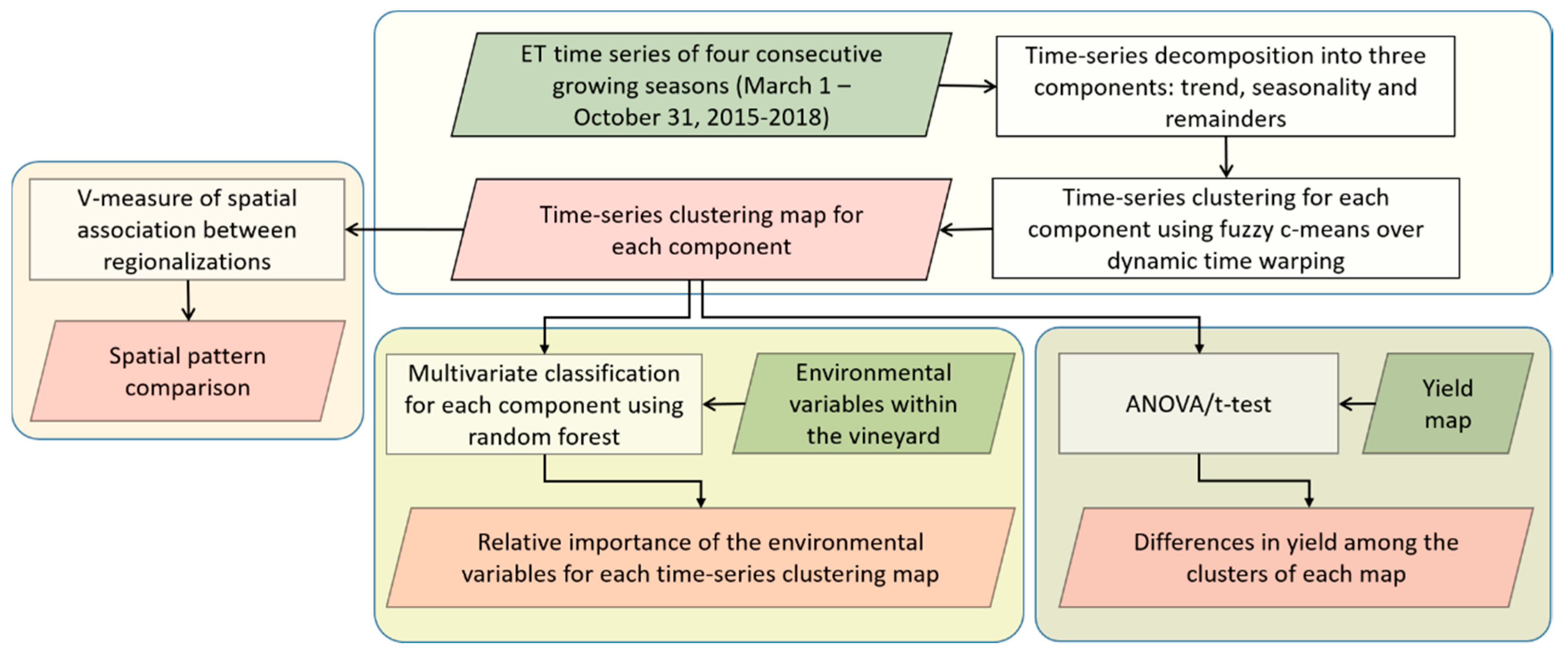
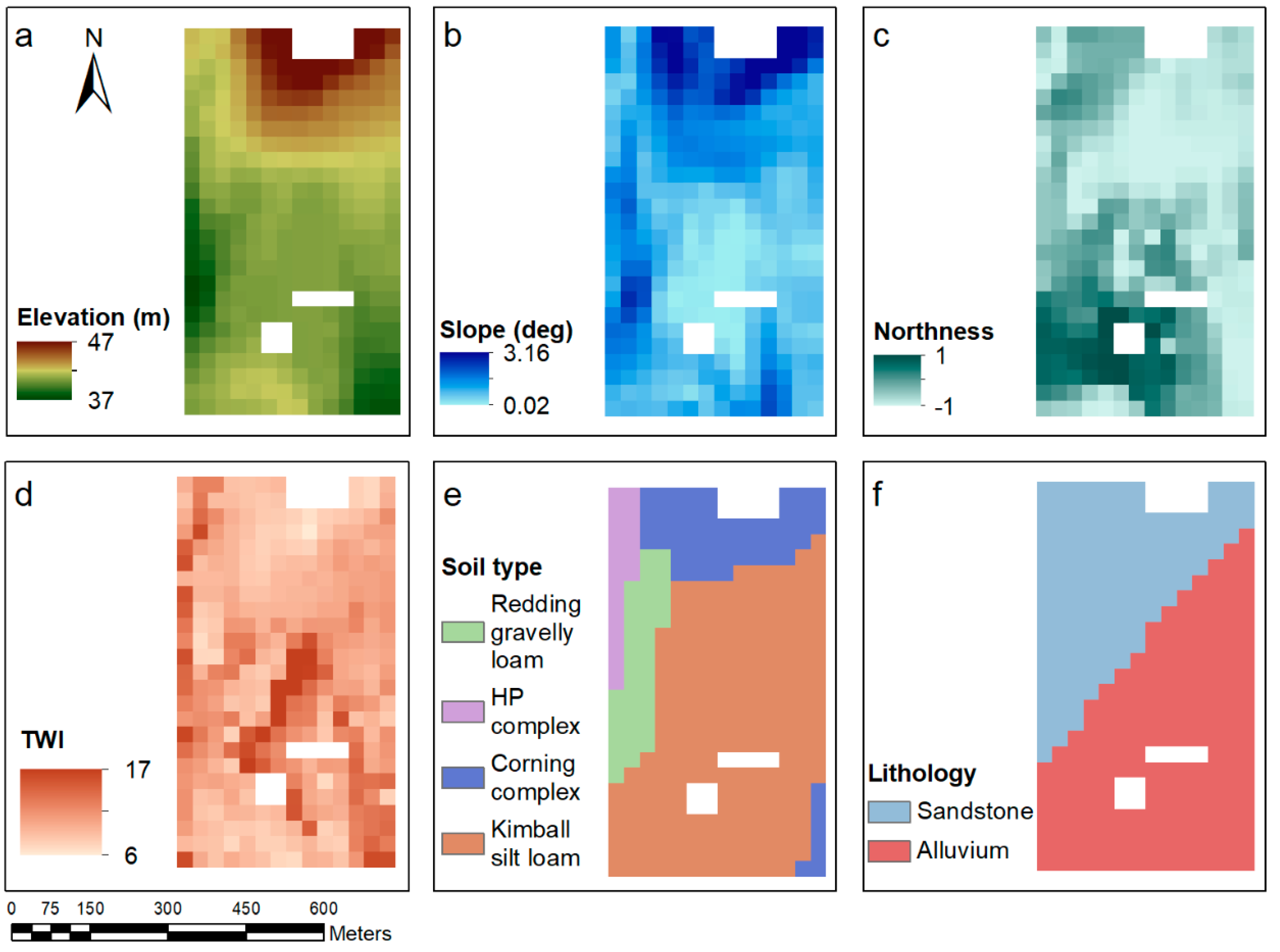
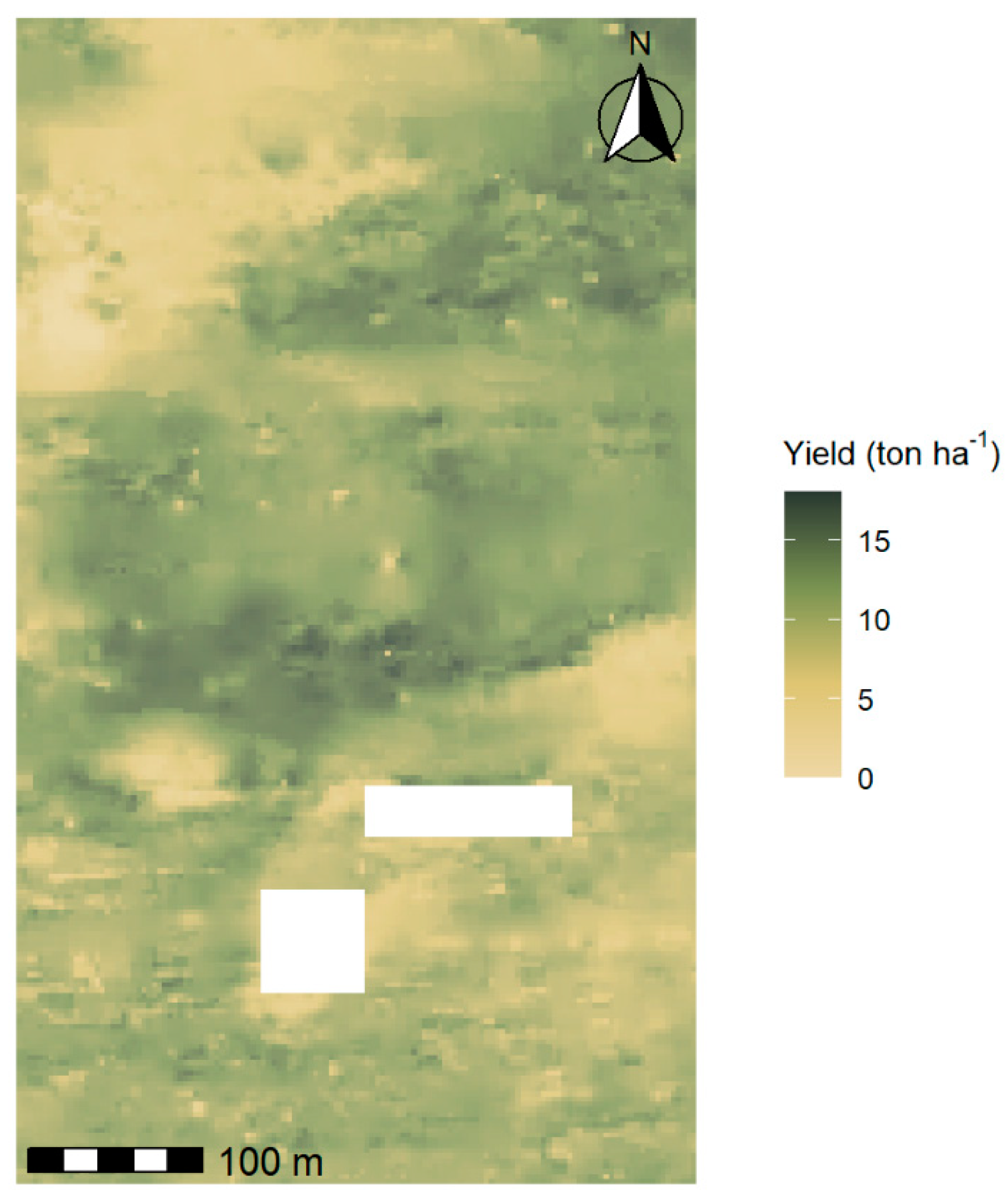
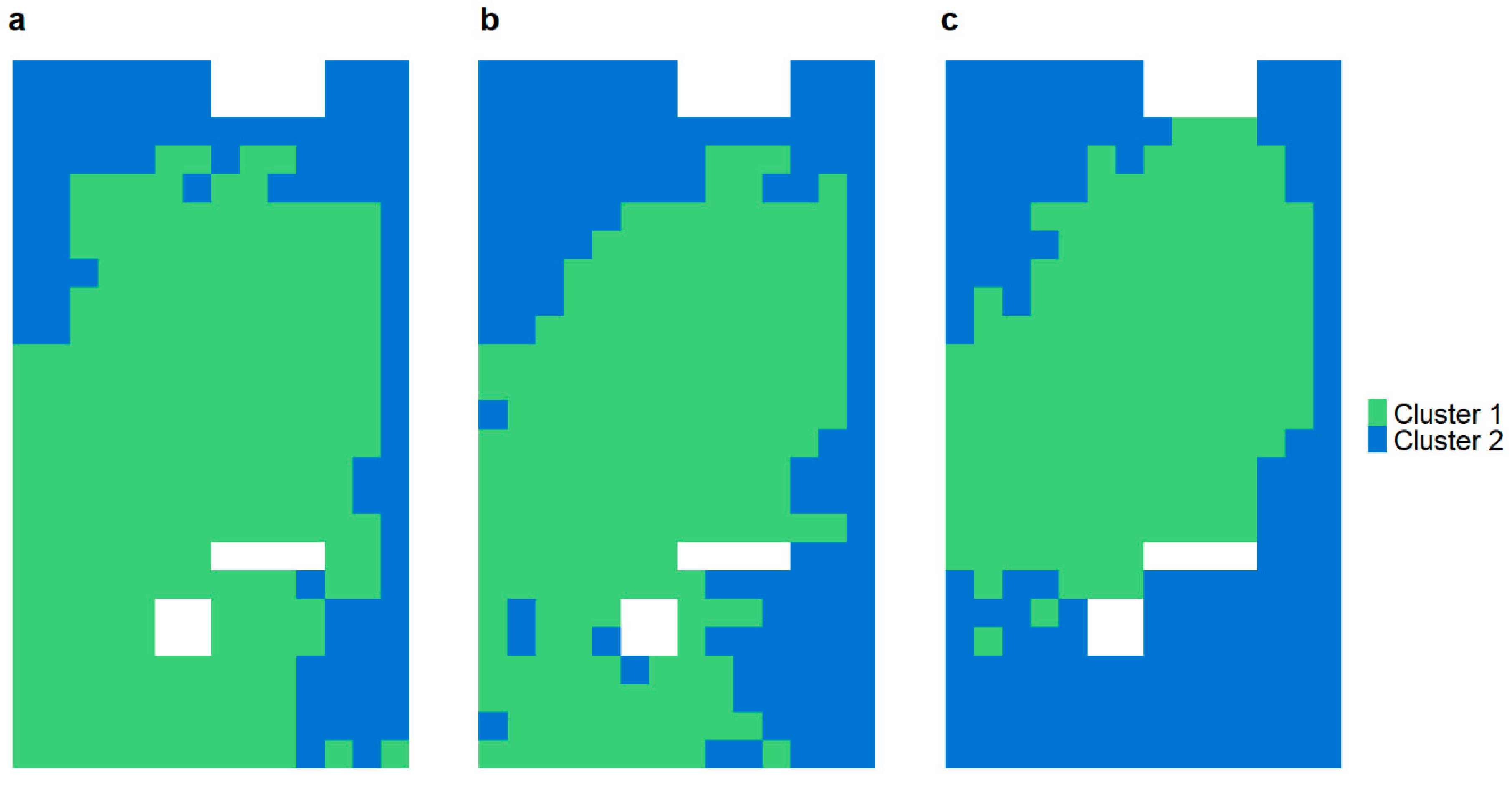
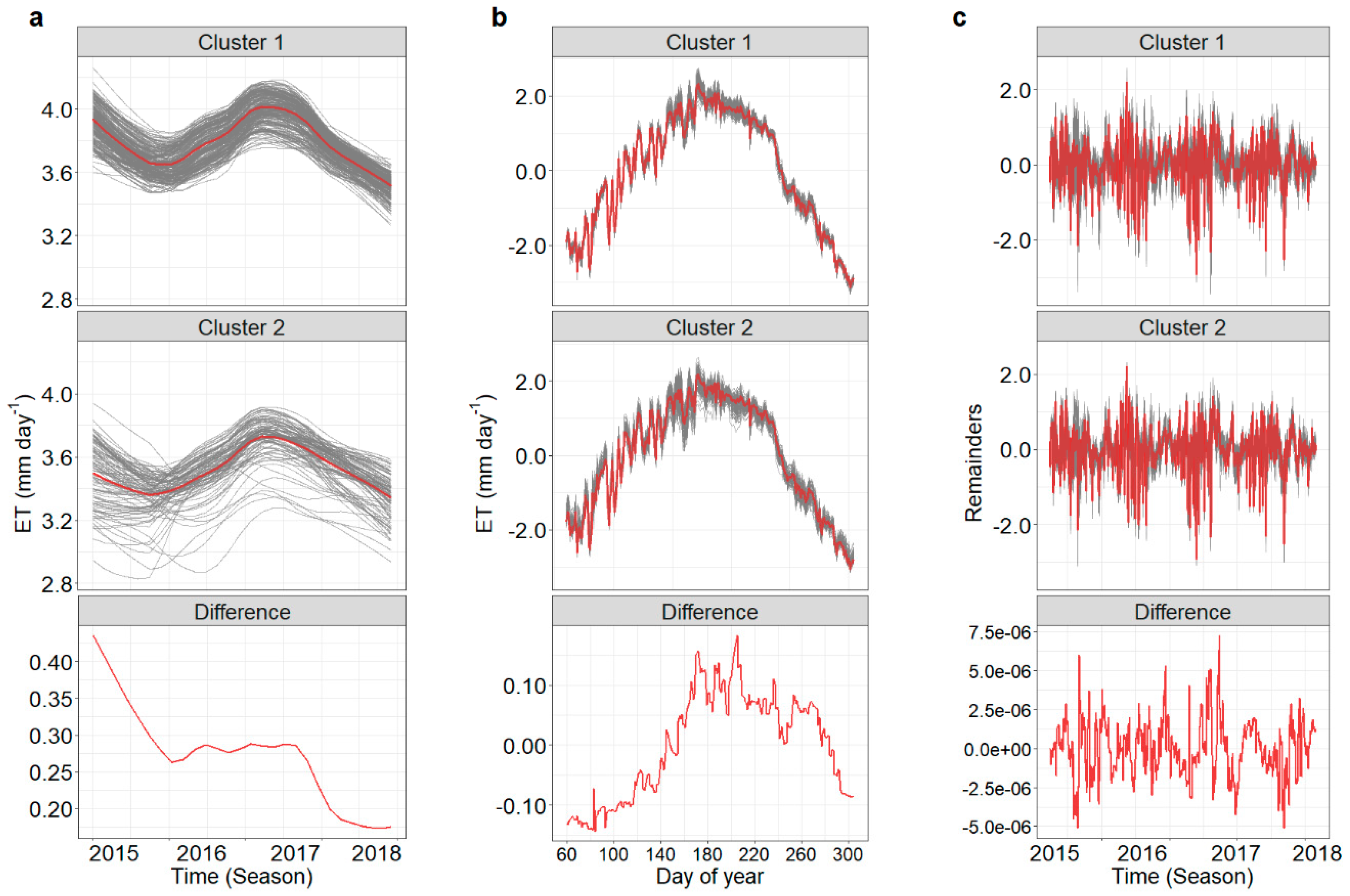

| Growing Season | Total Irrigation (mm) | Total Spring Precipitation (mm) | Number of Rainy Days | Sum of Irrigation and Precipitation (mm) |
|---|---|---|---|---|
| 2015 | 491.03 | 101.85 | 14 | 592.89 |
| 2016 | 479.87 | 114.33 | 18 | 594.20 |
| 2017 | 300 | 300.23 | 35 | 600.23 |
| 2018 | 306.69 | 226.82 | 23 | 533.51 |
| First Map | Second Map | Homogeneity | Completeness | V-Measure |
|---|---|---|---|---|
| seasonality TSC | Remainder TSC | 0.29 | 0.28 | 0.29 |
| seasonality TSC | Trend TSC | 0.46 | 0.51 | 0.49 |
| Remainders TSC | Trend TSC | 0.19 | 0.22 | 0.2 |
| Component (Time-Series Clustering) | Trend | Seasonality | Remainder |
|---|---|---|---|
| Error rate (%) (training) | 14.62 | 15.57 | 17.92 |
| Confusion matrix – class 1 error (training) | 0.05 | 0.09 | 0.15 |
| Confusion matrix – class 2 error (training) | 0.39 | 0.26 | 0.20 |
| Prediction accuracy (%) (testing) | 89.34 | 86.89 | 86.07 |
| Prediction accuracy (Kappa) (testing) | 0.75 | 0.72 | 0.72 |
| Component (Time-Series Clustering) | Mean Yield Cluster 1 (ton ha−1) | Mean Yield Cluster 2 (ton ha−1) | F-Value | p-Value |
|---|---|---|---|---|
| Trend | 10.52 | 8.57 | 6.82 | 0.01 |
| Seasonality | 11.09 | 8.36 | 20.21 | <0.001 |
| Remainders | 11.2 | 8.92 | 13.76 | <0.001 |
© 2020 by the authors. Licensee MDPI, Basel, Switzerland. This article is an open access article distributed under the terms and conditions of the Creative Commons Attribution (CC BY) license (http://creativecommons.org/licenses/by/4.0/).
Share and Cite
Ohana-Levi, N.; Knipper, K.; Kustas, W.P.; Anderson, M.C.; Netzer, Y.; Gao, F.; Alsina, M.d.M.; Sanchez, L.A.; Karnieli, A. Using Satellite Thermal-Based Evapotranspiration Time Series for Defining Management Zones and Spatial Association to Local Attributes in a Vineyard. Remote Sens. 2020, 12, 2436. https://doi.org/10.3390/rs12152436
Ohana-Levi N, Knipper K, Kustas WP, Anderson MC, Netzer Y, Gao F, Alsina MdM, Sanchez LA, Karnieli A. Using Satellite Thermal-Based Evapotranspiration Time Series for Defining Management Zones and Spatial Association to Local Attributes in a Vineyard. Remote Sensing. 2020; 12(15):2436. https://doi.org/10.3390/rs12152436
Chicago/Turabian StyleOhana-Levi, Noa, Kyle Knipper, William P. Kustas, Martha C. Anderson, Yishai Netzer, Feng Gao, Maria del Mar Alsina, Luis A. Sanchez, and Arnon Karnieli. 2020. "Using Satellite Thermal-Based Evapotranspiration Time Series for Defining Management Zones and Spatial Association to Local Attributes in a Vineyard" Remote Sensing 12, no. 15: 2436. https://doi.org/10.3390/rs12152436
APA StyleOhana-Levi, N., Knipper, K., Kustas, W. P., Anderson, M. C., Netzer, Y., Gao, F., Alsina, M. d. M., Sanchez, L. A., & Karnieli, A. (2020). Using Satellite Thermal-Based Evapotranspiration Time Series for Defining Management Zones and Spatial Association to Local Attributes in a Vineyard. Remote Sensing, 12(15), 2436. https://doi.org/10.3390/rs12152436






